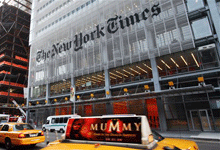Thursday’s offer of 20 voluntary buyouts for New York Times staff shows the continuing evolution of the newsroom — cuts to the print operation while trying to nurture online growth.
The Times’ digital staffers were excluded from the buyout offer because “that’s the way the industry is going, and they don’t want to lose people on that end of the business,” said Bill O’Meara, president of the Newspaper Guild of New York, which represents Times staff under separate contracts for print and digital employees.
In the memo announcing the buyouts, editors cited the “continuing and difficult challenge to The Times: how to rebalance our business for the digital age while remaining steadfast to the quality journalism that defines us?”
The Times’ negotiations with the Guild are part of that rebalancing. The two sides are negotiating a new contract to replace the separate ones for the print and online staffs. The goal is a unified agreement with many of the same terms regardless of whether an employee works on the print product or the website.
Many of the terms of the print contract are more generous than the digital one, which O’Meara said contained concessions in order to get those employees under Guild representation. “Digital was first negotiated when the Web was kind of like a wonderment,” he said.
“Certainly the company would like to have some of the more relaxed terms for the newspaper people, and we would like the Web people to have the better terms” that employees under the newspaper contract have, O’Meara said.
While the two sides disagree on financial terms, O’Meara said, they agree on a platform-agnostic approach in which people have print and Web duties. That’s a change from the Guild’s previous approach.
“There were protections put in place many years ago to make sure the print side people were not negatively impacted by the digital work,” O’Meara said. Now “we both agree that we should be platform-agnostic at this point, to the extent possible.”
In Thursday’s memo, editors said that employees covered by the digital contract were excluded from the buyout offer. This was in part “to ensure we do not cut too deeply in our journalistic muscle.”
Employees covered by the print contract also generally cost the company more, considering they’ve generally been at the company longer and their workweek is just 34.5 or 35 hours, depending on the shift, compared to the 40-hour workweek for online employees.
The Times wants to move all employees to a 40-hour workweek without a corresponding increase in salary, according to a Guild document outlining the Times’ proposal. The union wants to shorten digital employees’ workweek, O’Meara said.
Considering that the vast majority of union-represented employees are covered by the print contract — about 1,000 under the print contract and 100 under the digital one — extending the workweek alone could save the company a lot of money in overtime.
The Times also wants to eliminate daily overtime (employees now get overtime for working more than their shift on any one day) as well as a shift differential for working nights. (The pay increase for working the overnight shift, curiously, is called a “lobster differential.”)
Such regimented work rules made more sense on a daily news cycle with exacting copy deadlines, press runs and delivery schedules. But they’re harder for a Web operation, which operates 24/7 and publishes continually.
“We understand that there are changes in the industry,” O’Meara said. In general, though, whether talking about the workweek length, scheduling flexibility or restrictions on how soon an employee has to go back to work after his last shift ends, “We want people to have a normal life, as well as work for The New York Times.”
The Guild document obtained by Poynter.org is dated March 2011. O’Meara said there hadn’t been significant changes in the company’s proposal since then. Eileen Murphy, vice president for corporate communications at The Times Co., declined to comment beyond saying that negotiations are underway.
Some of the changes the Times wants are unrelated to the Web-print divide. For instance, the company has proposed no raises.
The Times also wants to freeze the pension plan: no new members and no more accrual of benefits for those already in the plan. That change would cut most employees’ pensions by 50 to 80 percent, according to the Guild. The company hasn’t committed to increasing its contribution to employees’ 401(k) plans to make up for that, O’Meara said.
And the company wants to put Guild members on management’s health insurance plan, which provides less coverage than the Guild’s. “We’re not interested in that,” O’Meara said. “We’d like to keep the Guild plan, and we’d like to get additional contributions from the company.”
The current contract expired March 30, but it remains in effect until the company and union reach a new agreement. That’s one reason that Guild employees who take the buyout will get three weeks of severance compared to non-union employees. The buyout memo says that the new contract will be signed “hopefully in the coming months.”







Comments